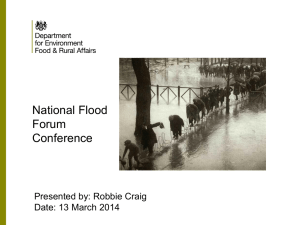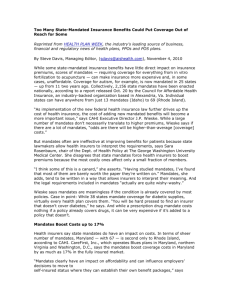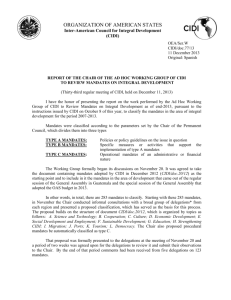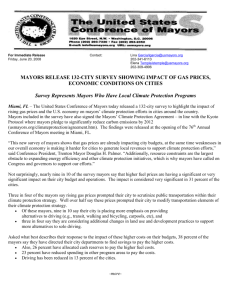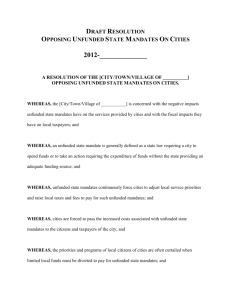Summit Panel Descriptions - U.S. Conference of Mayors
advertisement
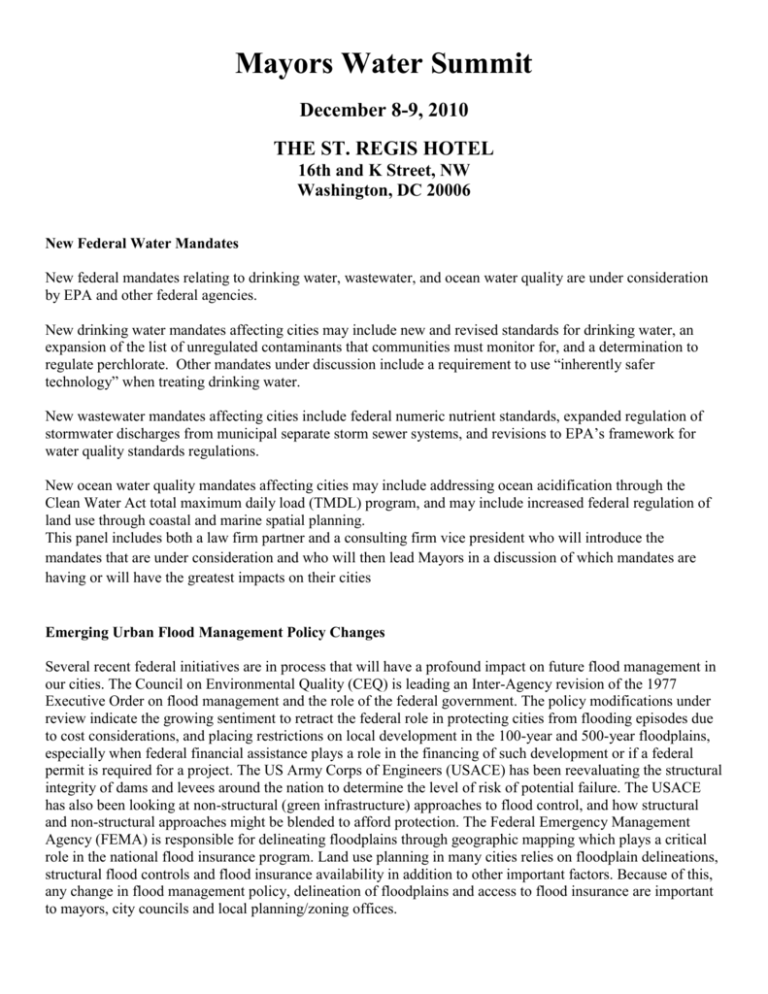
Mayors Water Summit December 8-9, 2010 THE ST. REGIS HOTEL 16th and K Street, NW Washington, DC 20006 New Federal Water Mandates New federal mandates relating to drinking water, wastewater, and ocean water quality are under consideration by EPA and other federal agencies. New drinking water mandates affecting cities may include new and revised standards for drinking water, an expansion of the list of unregulated contaminants that communities must monitor for, and a determination to regulate perchlorate. Other mandates under discussion include a requirement to use “inherently safer technology” when treating drinking water. New wastewater mandates affecting cities include federal numeric nutrient standards, expanded regulation of stormwater discharges from municipal separate storm sewer systems, and revisions to EPA’s framework for water quality standards regulations. New ocean water quality mandates affecting cities may include addressing ocean acidification through the Clean Water Act total maximum daily load (TMDL) program, and may include increased federal regulation of land use through coastal and marine spatial planning. This panel includes both a law firm partner and a consulting firm vice president who will introduce the mandates that are under consideration and who will then lead Mayors in a discussion of which mandates are having or will have the greatest impacts on their cities Emerging Urban Flood Management Policy Changes Several recent federal initiatives are in process that will have a profound impact on future flood management in our cities. The Council on Environmental Quality (CEQ) is leading an Inter-Agency revision of the 1977 Executive Order on flood management and the role of the federal government. The policy modifications under review indicate the growing sentiment to retract the federal role in protecting cities from flooding episodes due to cost considerations, and placing restrictions on local development in the 100-year and 500-year floodplains, especially when federal financial assistance plays a role in the financing of such development or if a federal permit is required for a project. The US Army Corps of Engineers (USACE) has been reevaluating the structural integrity of dams and levees around the nation to determine the level of risk of potential failure. The USACE has also been looking at non-structural (green infrastructure) approaches to flood control, and how structural and non-structural approaches might be blended to afford protection. The Federal Emergency Management Agency (FEMA) is responsible for delineating floodplains through geographic mapping which plays a critical role in the national flood insurance program. Land use planning in many cities relies on floodplain delineations, structural flood controls and flood insurance availability in addition to other important factors. Because of this, any change in flood management policy, delineation of floodplains and access to flood insurance are important to mayors, city councils and local planning/zoning offices. American Rivers, the premiere US environmental group dedicated to preserving and protecting domestic waterways, has been engaged in numerous efforts to work with local government, and one of those efforts includes providing information on the environmental and public benefits of green infrastructure as a flood control management tool. The Association of State Floodplain Managers is also involved in similar efforts. Mayors share in the major responsibility to protect the public, property and natural resources from natural disasters (e.g., flood events). They have experience working with the USACE, FEMA and other NGOs, and they bring a unique perspective to what is needed, what is practical to fulfill this responsibility. This session is intended to bring these parties together to share information on the current state-of-the-situation and what is being done to help cities with urban flood management efforts. National Implications of the Federal Pollution Limits for the Chesapeake Bay Clean-Up Under the Clean Water Act (CWA) the US EPA requires States to list impaired waters and then establish watershed implementation plans to limit nutrients such as nitrogen and phosphorus, and sediment pollution. The limits are established as enforceable Total Daily Maximum Loads (TMDLs); and this is essentially a pollution ‘diet’. The Chesapeake Bay Clean-Up initiative is the largest TMDL ever undertaken in the history of the CWA, and the federal government is taking the lead under a legal agreement with several NGOs. The State implementation plans will require local government to take significant steps to achieve compliance. The panel includes consulting engineers with extensive experience in community and regional nutrient management regulations and practices, along with Mayors who play an important role in providing leadership and financial investments to achieve compliance. This initiative may serve as a template for EPA and how it will regulate nutrient management in other regions. Water and Wastewater Infrastructure Financing Local government capital investment in water and wastewater infrastructure has experienced a significant decrease in inflation adjusted dollars over the last two decades. Many cities are fearful of system-wide failures; and this is demonstrated by the overwhelming number of pipe breaks each year. Add to that the burden of increasing federal mandates that increase requirements for both capital and O&M spending, and the result is an unsustainable situation. Expensive regulatory programs such as the EPA’s CSO Control Policy are causing local government leaders to seek greater financial support from state and federal government. Speakers on this panel offer information on how public private partnerships can provide cost-savings solutions. They also address using triple bottom line approaches to leveraging utility investments that yield multiple public benefits. Indianapolis has successfully recast its CSO control plan with new thinking on control solutions that avoids the more costly solutions.






